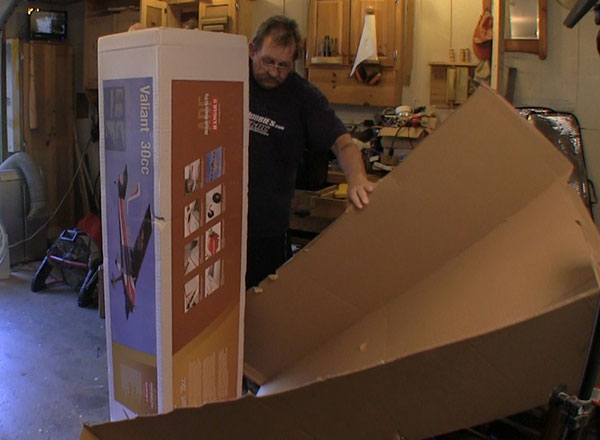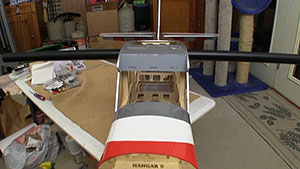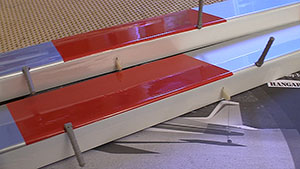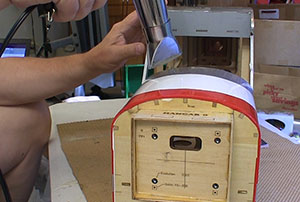



The Valiant arrived in a very big box and in very good condition.
Text, photos and video by Tom Hintz
Posted - 9-7-2016
I became a fan of the Hangar 9 Valiant 30cc after seeing one fly at our club field and then again in a video from a member of the FlyingRC.net Texas Bill Squad. Don’t get me wrong, I still love an over powered sky-ripper but a big, slow moving, rudder-intensive, high-lift high winger is also intriguing. The Hangar 9 Valiant 30cc sports a remarkable combination of low speed aerobatics and an unexpected level of high speed and vertical performance with a 35cc engine. Also, having recently been designated as one of our clubs “Introductory Pilots” the Hangar 9 Valiant 30cc gives me the opportunity to see that glassy-eyed look when a prospective pilot sees what they are about to try fling, albeit via a buddy box because I am not yet an idiot.
It is important to note that when we bought the Hangar 9 Valiant 30cc from Horizon Hobby (about 8-15-2016) they not only had the plane on sale for $599.99 (Normally $679.99) they also add free shipping to my door with no oversize charges slipped in the final price. Overall that is a savings of nearly $200.00! (8-23-2016) With so many retailers adding significant flat rate shipping charges, often increased with additional oversize charges this is a remarkable savings for real world consumers that lack an unlimited hobby budget.
The Hangar 9 Valiant 30cc has a wingspan of 108.3 in (275 cm) and an overall length of 78.2 in (199 cm). The generous wing area of 1663.0 sq. in. (107.3 sq. dm.) and projected flying weight between 16.5 - 17.5 lb (7.48 - 7.94 kg) yields a wing load of approximately 23-24 oz/sq ft. That big wing and the power of 30 to 40cc gas engines that RC’rs are stuffing in the Hangar 9 Valiant 30cc cowl only partially explain this planes’ unexpectedly expansive flight envelope.
The Hangar 9 Valiant 30cc firewall comes pre drilled and blind nuts installed as part of a not-so-subtle sales job for the Evolution 33cc engine sold by Horizon Hobby. For the electric folks, they say a Power 160 motor handles this plane well which appears to be true judging by everything I have seen. But for the gasser crowd the DLE 35RA or the DLE40 Twin as I am using give the Hangar 9 Valiant 30cc that extra punch and long flight times we expect from our planes.

A key to a good flying plane is the
alignment of the wing and tail feathers.
The Valiant was right on out of the box.
I have the benefit of friends who already own and fly the Hangar 9 Valiant 30cc. One, Bill R (Texas Bill Squad) suggested the EP (electric power) Mount Set for the Valiant 30cc (HAN506012 - $18.99) which includes among other things a “battery mount” tray that is secured with a simple finger bolt not unlike the ones that secure the wing panels. As with many planes with a cabin like the Hangar 9 Valiant 30cc the gas tanks often wind up going under the difficult to reach “dash” area. Bill used the “battery tray” to make installing and servicing the fuel tank way easier. The electric power kit was ordered with my Hangar 9 Valiant 30cc.
I also will be replacing the included pin hinges on the flaps with similar but better quality Robart pin hinges. This is way too cheap of an upgrade to let slide. I plan to be using the flaps a bunch as we see how good of a STOL (steep takeoff and landing) plane the Hangar 9 Valiant 30cc can be.
The Hangar 9 Valiant 30cc comes with nice looking wheels and wheel pants but my focus on STOL (short take-off and landing) flying with this plane just begged for large, balloon type tires. A set of 6” DuBro balloon tires and a set of 5/32”, 2”-long DuBro axles will be installed on the included aluminum landing gear. You also have the option of using Hangar 9 Cub type gear mounted to factory installed blind nuts in the Hangar 9 Valiant 30cc but I like the simplicity (and easily repair) of the standard aluminum gear.
As I do with all new planes I went through the box to be sure nothing was damaged. I also looked for open bags or boxes of components that might have turned something small but important loose in the main shipping box. The Hangar 9 Valiant 30cc had none of those issues.
While it is admittedly rare to find obvious manufacturing errors or damage I do look for them as I go over the parts. This initial inspection can also bring to mind accessories I might need to complete the build or changes to the accessories I had originally planned on using. The only hardware change I found was the engine mounting bolts that turned out to be 10/32 rather than the 5mm I was expecting. More on this when we get to installing the DLE40 Twin later in this review.
The most remarkable thing about what I found in the box is the pure size of the Hangar 9 Valiant 30cc. I have seen them in person, flown one and watched a ton of video but there is something about pulling the horizontal stabilizer out of its storage space in the big box that drives the “I’m big” point home. I am certain that I have flown RC planes for people that had smaller wingspans than the 37”-wide Hangar 9 Valiant 30cc horizontal stabilizer.

Large, Robart-style pin hinges are light
and very strong.
Another tradition of mine with new models is going over the covering to find unsealed edges or loose covering. Both are common issues with an airframe that was covered and shipped from a distant country or one that simply sat on a shelf for a while. Covering loosens, get over it.
My first pass over the covered parts is with the covering iron set to roughly 50% of its power to stick the covering down rather than shrink it. I use this on all of the seams and edges of covering to be sure they are all sealed completely. Once satisfied with the edges I switch to my heat gun and shrink out any loose sections of covering. Once again the Hangar 9 Valiant 30cc arrived in surprisingly good shape with only minor edges and loose sections needing attention. Despite the huge square footage of covering on the Hangar 9 Valiant 30cc covering prep took only about an hour.
Because I am using a DLE40 Twin in the Hangar 9 Valiant 30cc I decided to get that mounted first so I could more easily determine if I need to order anything to complete that installation. The pre-installed blind nuts in the Hangar 9 Valiant 30cc firewall for the suggested Evolution engine happen to be in the same pattern as needed by the DLE40 Twin so I lucked out there with a bolt up fit.
The biggest motor-related issue came when I could not find a firewall to prop washer dimension in the instructions. After some fussing with a mocked up cowl and fuse it looked like a 153mm firewall to prop washer dimension was right on the money. Using the aluminum standoff included with the Hangar 9 Valiant 30cc plus a ¼”-thick spacer added to each of those (approximately 18mm total standoff height) should put the DLE40 Twin within fudging range of the perfect cowl installation. I had to get 1-1/2”-long 10/32 bolts to mount the DLE40 Twin using the factory installed blind nuts.

The motor box is tough and the covering
needed minor touch ups.
The Hangar 9 Valiant 30cc tail feathers are impressive in their size but such large dimensions can be a problem transporting. To help that the horizontal and vertical stabilizers can be bolted in place, secured to factory set blind nuts. You have the option to epoxy some or all of these components in place in addition to the bolts and that is the option I chose. My Hangar 9 Valiant 30cc rides to and from the field in my trailer so I can avoid the tail feather assembly steps at the field.
After marking the vertical stabilizer position on the horizontal stab and carefully removing the covering I applied epoxy and bolted the vertical stab to the horizontal piece. I used a square to be sure these components were exactly 90-degrees to each other. There was a small miss alignment so I put a strip of masking tape from the top of the vertical stab to the outside edge of the horizontal stab to apply enough tension so that when the epoxy cured they would be at exactly 90-degrees.
We still have the option of attaching the tail feather unit with screws or epoxying it to the airframe. To better insure precise alignment I decided to use epoxy to secure the tail feathers bolstered with the included screws to add clamping pressure. As I tightened the horizontal stab bolts I put the wing tube in and sighted across that to the tail feathers to be sure they were parallel with each other. This is another place where taking your time to get this right can substantially improve the flight characteristics of the plane.
I also decided to install the flaps which use large pin type hinges that are secured with epoxy. The Hangar 9 Valiant 30cc kit comes with the pin hinges but the Texas Bill Squad member who bought this plane for me had changed those out for Robart pin hinges and he added a bag of those to the order that was delivered to me.
One side of the pin hinges had to be shortened to 1” to fit the pre-drilled holes. The flap and ailerons come stapled together in “left” and “right” sets but neither was marked so I just dumped them all out to prep. It is easy enough to figure out what goes where by the location of the strips and factory-installed control horns on the flaps and the striping on the bottom of the ailerons.
After checking the fit of the hinges and flaps I took everything apart, applied epoxy to the hinges and control surfaces. I assembled pieces taking the time to wipe up excess epoxy that squeezed out. Using masking tape, I secured both flaps so they would maintain their position while the epoxy (10-minute setup time) cured.
The tail wheel wire fits into a factory cut groove and hole in the rudder so I test fit that assembly including on the airframe to be sure all of the mounting holes lined up. I had heard early Hangar 9 Valiant 30cc kits has an issue here but that appears to be long gone. I applied epoxy to the groove and hole, set the tail wheel wire in place and secured it with masking tape while the epoxy cured.
Hinging has never been my favorite part of building a plane so hearing that the CA hinges included with the Hangar 9 Valiant 30cc work well was heartening. The CA hinges are good sized and seem more robust than I see in kits these days.
All of the control surfaces except for the flaps are hung using the CA hinges and a check of the parts shows that slots have been cut for the hinges. However, as I always have to do with pre-slotted ARF’s, I had to go over all of the slots with a hinging hook. The instructions call for drilling a 1/16” center hole for each hinge to help get CA glue over more of the hinge surface in the wood. Once the slots were cleared and the holes drilled I had the Hangar 9 Valiant 30cc hinged in 20 minutes.
The control horns included with the Hangar 9 Valiant 30cc look to be well made and sized for the throws this plane needs. The flap control horns are factory installed with all other surfaces pre-drilled for the included horns.
Coming in the next Hangar 9 Valiant 30cc build segment we will install the radio gear including servos and their linkages. The DLE40 Twin also gets mounted as does its RotoFlow 16oz tank.
Visit the Hangar 9 Valiant 30cc product page – Click Here
Have a comment on this Review? –Email Me!